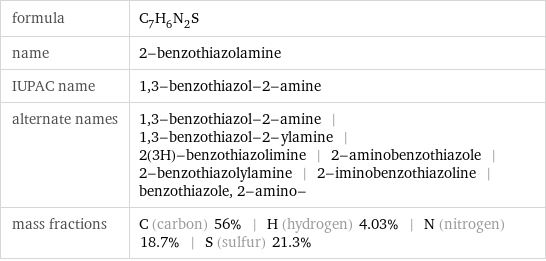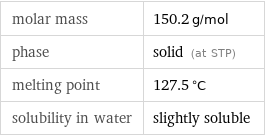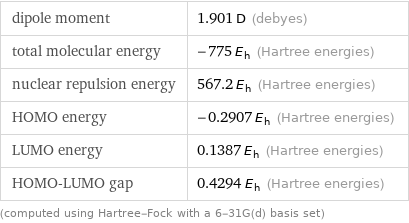Input interpretation

2-benzothiazolamine
Chemical names and formulas

formula | C_7H_6N_2S name | 2-benzothiazolamine IUPAC name | 1, 3-benzothiazol-2-amine alternate names | 1, 3-benzothiazol-2-amine | 1, 3-benzothiazol-2-ylamine | 2(3H)-benzothiazolimine | 2-aminobenzothiazole | 2-benzothiazolylamine | 2-iminobenzothiazoline | benzothiazole, 2-amino- mass fractions | C (carbon) 56% | H (hydrogen) 4.03% | N (nitrogen) 18.7% | S (sulfur) 21.3%
Lewis structure

Draw the Lewis structure of 2-benzothiazolamine. Start by drawing the overall structure of the molecule, ignoring potential double and triple bonds: Count the total valence electrons of the carbon (n_C, val = 4), hydrogen (n_H, val = 1), nitrogen (n_N, val = 5), and sulfur (n_S, val = 6) atoms: 7 n_C, val + 6 n_H, val + 2 n_N, val + n_S, val = 50 Calculate the number of electrons needed to completely fill the valence shells for carbon (n_C, full = 8), hydrogen (n_H, full = 2), nitrogen (n_N, full = 8), and sulfur (n_S, full = 8): 7 n_C, full + 6 n_H, full + 2 n_N, full + n_S, full = 92 Subtracting these two numbers shows that 92 - 50 = 42 bonding electrons are needed. Each bond has two electrons, so in addition to the 17 bonds already present in the diagram add 4 bonds. To minimize formal charge nitrogen wants 3 bonds and carbon wants 4 bonds. Identify the atoms that want additional bonds and the number of electrons remaining on each atom: Fill in the 4 bonds by pairing electrons between adjacent highlighted atoms. Note that the six atom ring is aromatic, so that the single and double bonds may be rearranged: Answer: | |
3D structure

3D structure
Basic properties

molar mass | 150.2 g/mol phase | solid (at STP) melting point | 127.5 °C solubility in water | slightly soluble
Units

Molecular properties

dipole moment | 1.901 D (debyes) total molecular energy | -775 E_h (Hartree energies) nuclear repulsion energy | 567.2 E_h (Hartree energies) HOMO energy | -0.2907 E_h (Hartree energies) LUMO energy | 0.1387 E_h (Hartree energies) HOMO-LUMO gap | 0.4294 E_h (Hartree energies) (computed using Hartree-Fock with a 6-31G(d) basis set)
Chemical identifiers

CAS number | 136-95-8 Beilstein number | 116315 PubChem CID number | 8706 PubChem SID number | 24846830 SMILES identifier | C1=CC=C2C(=C1)N=C(S2)N InChI identifier | InChI=1/C7H6N2S/c8-7-9-5-3-1-2-4-6(5)10-7/h1-4H, (H2, 8, 9)/f/h8H2 RTECS number | DL1050000 MDL number | MFCD00005785
NFPA label

NFPA label

NFPA health rating | 1 NFPA fire rating | 0 NFPA reactivity rating | 0
Toxicity properties

RTECS classes | mutagen